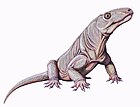
Gorgonopsia is an extinct group of sabre-toothed therapsids from the Middle to Upper Permian roughly 265 to 252 million years ago. They are characterised by a long and narrow skull, as well as elongated upper and sometimes lower canine teeth and incisors which were likely used as slashing and stabbing weapons. Postcanine teeth are generally reduced or absent. For hunting large prey, they possibly used a bite-and-retreat tactic, ambushing and taking a debilitating bite out of the target, and following it at a safe distance before its injuries exhausted it, whereupon the gorgonopsian would grapple the animal and deliver a killing bite. They would have had an exorbitant gape, possibly in excess of 90°, without having to unhinge the jaw.

Biarmosuchia is an extinct clade of non-mammalian synapsids from the Permian. Biarmosuchians are the most basal group of the therapsids. They were moderately-sized, lightly-built carnivores, intermediate in form between basal sphenacodont "pelycosaurs" and more advanced therapsids. Biarmosuchians were rare components of Permian ecosystems, and the majority of species belong to the clade Burnetiamorpha, which are characterized by elaborate cranial ornamentation.

Inostrancevia is an extinct genus of carnivorous therapsids, containing the largest members of the family Gorgonopsidae, predators characterized by long, saber-tooth-like canines. The various species inhabited northern Russia during the Upper Tatarian (Vyatskian), a Russian regional stage equivalent to the Wuchiapingian stage of the Late Permian period, dating from approximately 259 to 252.3 million years ago. It is known from several skulls and two almost-complete skeletons.

Lycaenops ("wolf-face") is a genus of carnivorous therapsids. It lived during the late mid-Permian to the early Late Permian, about 270.6-251 mya, in what is now South Africa.

Dinogorgon is a genus of gorgonopsid from the Late Permian of South Africa and Tanzania. The generic name Dinogorgon is derived from Greek, meaning "terrible gorgon", while its species name rubidgei is taken from the surname of renowned Karoo paleontologist, Professor Bruce Rubidge, who has contributed to much of the research conducted on therapsids of the Karoo Basin. The type species of the genus is D. rubidgei.
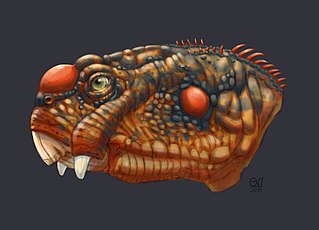
The Daptocephalus Assemblage Zone is a tetrapod assemblage zone or biozone found in the Adelaide Subgroup of the Beaufort Group, a majorly fossiliferous and geologically important geological Group of the Karoo Supergroup in South Africa. This biozone has outcrops located in the upper Teekloof Formation west of 24°E, the majority of the Balfour Formation east of 24°E, and the Normandien Formation in the north. It has numerous localities which are spread out from Colesberg in the Northern Cape, Graaff-Reniet to Mthatha in the Eastern Cape, and from Bloemfontein to Harrismith in the Free State. The Daptocephalus Assemblage Zone is one of eight biozones found in the Beaufort Group and is considered Late Permian (Lopingian) in age. Its contact with the overlying Lystrosaurus Assemblage Zone marks the Permian-Triassic boundary.

Arctops is an extinct genus of gorgonopsian therapsids known from the Late Permian of South Africa. It measured up to 2 metres in length and its skull was 30 centimetres (12 in) long. The type species is Arctops willistoni. A second species, A. watsoni, may be synonymous with A. willistoni. A. kitchingi may be a third species of Arctops, but it was only tentatively assigned to the genus when it was first named. Both were formally synonymized with A. willistoni by Christian Kammerer in 2017.

Arctognathus is an extinct genus of gorgonopsids that throve during the Late Permian in the Karoo basin of what is now South Africa.

Aelurognathus is an extinct genus of gorgonopsian therapsids from the Permian of South Africa.
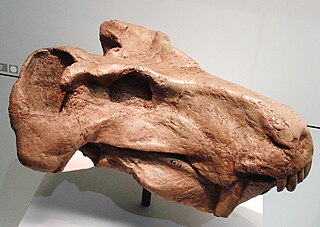
Rubidgea is a genus of gorgonopsid from the upper Permian of South Africa and Tanzania, containing the species Rubidgea atrox. The generic name Rubidgea is sometimes believed to be derived from the surname of renowned Karoo paleontologist, Professor Bruce Rubidge, who has contributed to much of the research conducted on therapsids of the Karoo Basin. However, this generic name was actually erected in honor of Rubidge's paternal grandfather, Sydney Rubidge, who was a renowned fossil hunter. Its species name atrox is derived from Latin, meaning “fierce, savage, terrible”. Rubidgea is part of the gorgonopsian subfamily Rubidgeinae, a derived group of large-bodied gorgonopsians restricted to the Late Permian (Lopingian). The subfamily Rubidgeinae first appeared in the Tropidostoma Assemblage Zone. They reached their highest diversity in the Cistecephalus and Daptocephalus assemblage zones of the Beaufort Group in South Africa.
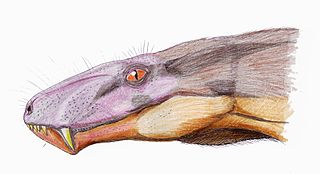
Cyonosaurus is a genus of gorgonopsian therapsids from the Late Permian of South Africa. Cyonosaurus was 0.6 to 1.1 metres in length, with a skull 9 to 18 centimetres in length. The type species Cyonosaurus longiceps was named in 1937.

Aloposaurus is an extinct genus of gorgonopsian therapsids from the Late Permian of South Africa. It was first named by Robert Broom in 1910, and contains the type species A. gracilis, and possibly a second species A. tenuis. This small gorgonopsid had a slender narrow skull only 12 centimetres (4.7 in) long, with a total body length of 60–70 cm (2.0–2.3 ft). Aloposaurus is known from a single weathered skull from a probable immature individual.

Aelurosaurus is a small, carnivorous, extinct genus of gorgonopsian therapsids from the Mid Permian to Late Permian of South Africa. It was discovered in the Karoo Basin of South Africa, and first named by Richard Owen in 1881. It was named so because it appeared to be an ancestor for cat-like marsupials, but not yet a mammal itself. It contains five species, A. felinus, A. whaitsi, A. polyodon, A. wilmanae, and A.? watermeyeri. A. felinus, the type species, is generally well described with established features, while the other four species are not due to their poorly preserved holotypes.
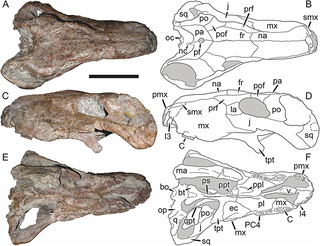
Sycosaurus is an extinct genus of rubidgeine gorgonopsians from the Usili Formation of Tanzania. It was medium-sized, about 1.2 m in length. It was first named by Haughton in 1924, and contains two species, S. laticeps and S. nowaki.
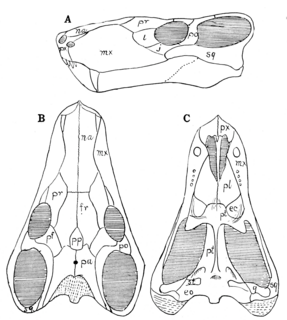
Scylacops is an extinct genus of Gorgonopsia. It was first named by Broom in 1913, and contains two species, S. bigendens, and S. capensis. Its fossils have been found in South Africa and Zambia. It is believed to be closely related to the Gorgonopsian Sauroctonus progressus. Scylacops was a moderately sized Gorgonopsid.
Cerdorhinus is an extinct genus of gorgonopsian therapsids from the Permian of South Africa. The type species Cerdorhinus parvidens was named by South African paleontologist Robert Broom in 1936. A second species, Cerdorhinus rubidgei, was named in 1970. In 2007, it was reassigned to the genus Cyonosaurus.

Eriphostoma is an extinct genus of gorgonopsian therapsids known from the Middle Permian of Tapinocephalus Assemblage Zone, South Africa. It has one known species, Eriphostoma microdon, and was first named by Robert Broom in 1911. It is the oldest known gorgonopsian and among the smallest and most basal members of the clade.

Smilesaurus is an extinct genus of gorgonopsian known from Africa. It lived during the Late Permian. It contains the single species S. ferox.

Ruhuhucerberus is a genus of very large, extinct gorgonopsian therapsids which existed in Tanzania during the Late Permian. Its fossils are found in the Penman Kawinga Formation of the Ruhuhu Basin. It existed sympatrically with the even larger Rubidgea.
Njalila is an informal name for a genus of gorgonopsian therapsids from the Late Permian of southern Africa. Fossils have been found from Malawi, Zambia, and Tanzania.




















